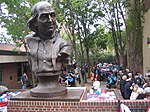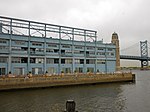Betsy Ross House

The Betsy Ross House is a landmark in Philadelphia purported to be the site where the seamstress and flag-maker Betsy Ross (1752-1836) lived when she is said to have sewed the first American Flag. The origins of the Betsy Ross myth trace back to her relatives, particularly her grandsons, William and George Canby, and the celebrations of the Centennial of 1876. Evidence for the precise location of Ross's home came from verification provided by several surviving family members, although the best archival evidence indicates the house would have been adjacent to the one that still stands today as The Betsy Ross House. The 1937 Philadelphia Guide noted that, after the current Betsy Ross House was selected as the Flag House, the adjacent building where Ross may have indeed lived "was torn down to lessen the hazards of fire, perhaps adding a touch of irony to what may well have been an error in research." Although the house is one of the most visited tourist sites in Philadelphia, the claim that Ross once lived there, and that she designed and sewed the first American flag, sometimes called the Betsy Ross flag, are considered false by most historians.The house sits on Arch Street, several blocks from Independence Hall and the Liberty Bell in Philadelphia, Pennsylvania. The front part of the building was built around 1740, in the Pennsylvania colonial style, with the stair hall and the rear section added 10 to 20 years later. Had she lived here, Ross would have resided in the house from 1776, the death of her first husband, John Ross, until about 1779.
Excerpt from the Wikipedia article Betsy Ross House (License: CC BY-SA 3.0, Authors, Images).Betsy Ross House
Arch Street, Philadelphia Center City
Geographical coordinates (GPS) Address Website External links Nearby Places Show on map
Geographical coordinates (GPS)
| Latitude | Longitude |
|---|---|
| N 39.95224 ° | E -75.14464 ° |
Address
Betsy Ross House
Arch Street 239
19106 Philadelphia, Center City
Pennsylvania, United States
Open on Google Maps








